Is the internet nurturing a new breed of packaging buyers?
December 2, 2015

The rise of the internet the past 20 years has been a blessing and a scourge at the same time for both packaging buyers and suppliers. A key challenge for both parties is the sheer amount of channels and content available to facilitate purchases. Buyers are overwhelmed by posted content, and suppliers are challenged to optimize their marketing budgets across ever increasingly segmented online channels.
We researched packaging buyer’s online buying behavior to help all parties in the packaging industries worldwide make better make use of their time and resources. Most similar studies in the past focused on reporting from only the supplier marketing function. Here we report on the experiences, needs and opinions of 153 qualified packaging buyers who used the internet to facilitate a purchase in 2014. The goal of the exercise was to improve the buyer’s online experiences in the future and to aid supplier marketing tactics in the industry.
Modern business-to-business (B2B) buyers and packaging buying teams now frequently delay their first interactions with sales people until they complete about 60% of their purchase process (CEB, 2011). One can hypothesize that a majority of the buying team’s time is spent online researching various aspects of the purchase, and discussing findings online with each other in real time. These are the new realities of modern online buying team’s behavior.
The buyers were asked 22 questions about a purchase they made last year. Results should enable buying teams to benchmark their own online behaviors against similar industry practices and other competitive buying teams. The results reported here are just a synopsis of our findings. Click here to download the full free report.
Mapping internet usage during buying stages
Four buying stages were presented to survey participants as shown in Figure 1 and buyers were asked in which stages did they use the internet for the purchase (more than one answer was possible). Interestingly, during the qualification process, 43% (116 out of 267 participants) who purchased something significant in 2014 did not use the internet to facilitate the process. We did not ask these people why not, although future research will consider why not.
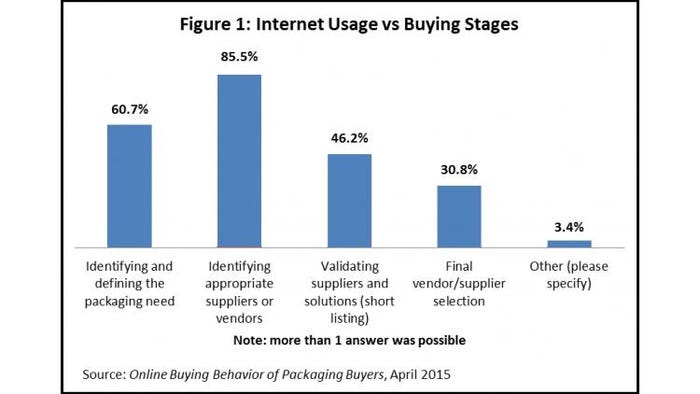
Next, we mapped the same buying stages against 14 different types of online and offline information sources as shown in Figure 2. More than 78% of the buyers did not use Facebook and 83% did not use Twitter during the process. LinkedIn is used quite often (probably for personal references and queries), which is no surprise as it compares quite similarly to advice from a colleague or friend in the early stages of buying.
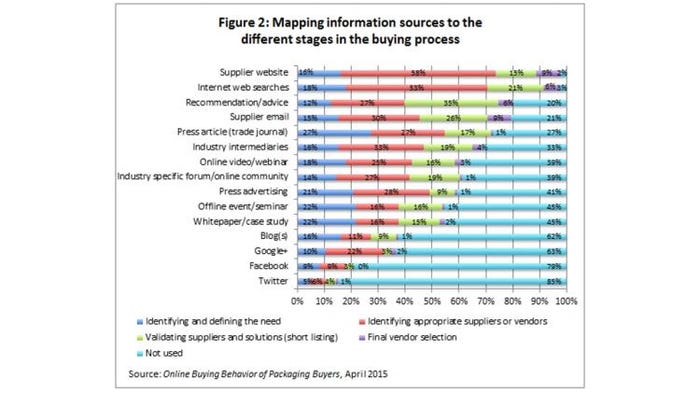
As can be expected there is a correlation between the budget for the project and the distanced searched (see Figure 3). As the budgets went up to $6 million (U.S. dollars), people tended to search farther from their location.
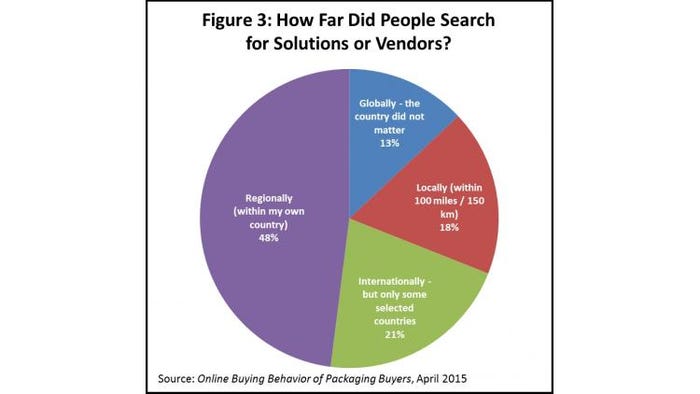
Impact, Effort, Intent, Reputation
Smart and sophisticated online buyers today use a variety of means to check and verify the reputation of new vendors.
As shown in Figure 4, across the four buyer roles, the importance of customer testimonials and case studies decreases (the top band), while best practices and peer reviews constitutes one third of the needs of the buyers. While many vendors try to post neutral unbiased peer reviews of their products or services, the impact of such commentary is somewhat less valuable than simple product information.
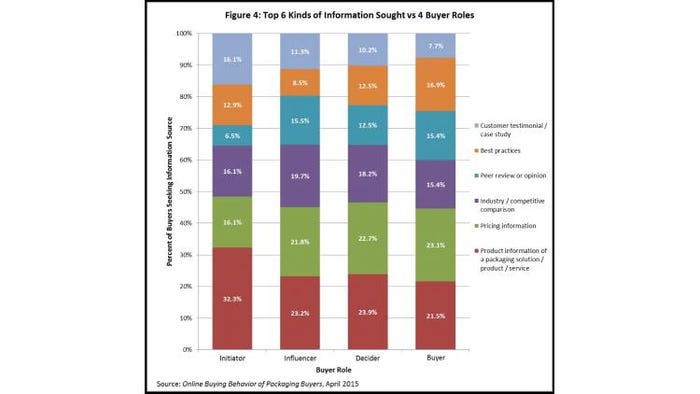
Buyers were asked to rate the online information that they collected on four factors using a 0.0 to 10.0 scale. The terms were defined as:
Impact—simplifies complex issues, provides alternative strategic choices, shows future benefits leading to growth.
Effort—easy to access promised information, no barrier to get information, worthwhile.
Intent—focuses on providing insights and education, does not request anything from you beyond your attention.
Reputation—instills confidence, comes from a peer referral, trustworthy.
The results of these ratings for more than 350 combined information sources is shown in Figure 5. Note that about one third of the buyers score effort less than 6.0, meaning that it is difficult to find or get the right information that they want using the internet. Specifically we found that industry analyst reports, industry competitive information and technology primers were hard to find with median ratings of around 5.4. Another finding showed about one third of buyers rated the intent of the online content below 6.0. Further detailed analysis can be found in the free report.
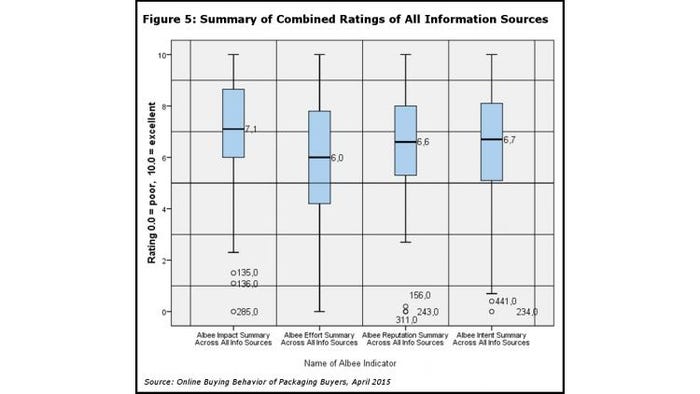
Social buyer?
Buyers were asked to rate three different pre-defined benefits of using social media or a fourth option: no benefit at all. The three different benefits are summarized as “Supplier research on social media networks…”
(1) “helped me to widen or strengthen my knowledge or expertise about a specific vendor”;
(2) “helped speed up information transfer to other buying team members”;
(3) “helped keep my supplier-counterpart informed about important events or changes within my company which may affect them.”
The ratings used a five-answer Likert scale as shown in Figure 6. The results show that 50% of the buyers report that they did not derive any benefits from social media when making purchasing decisions; while 13% did not know. On the positive side, we see that 37% did report deriving some benefits.
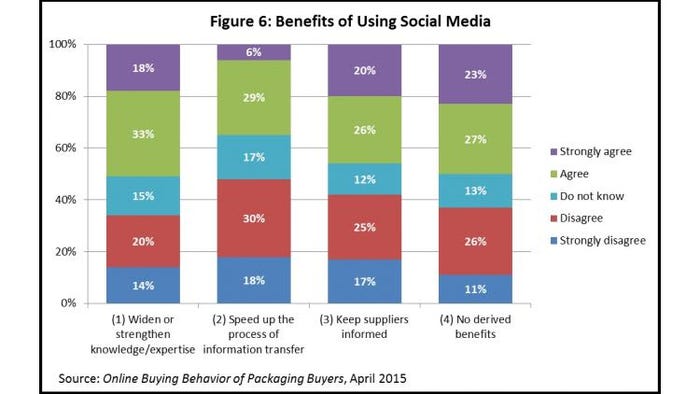
Overall smoothness of the purchase process
More than 100 buyers rated the overall smoothness of the online buying process with regards to working together with colleagues and/or external advisors or suppliers. Figure 7 shows a large distribution of responses.
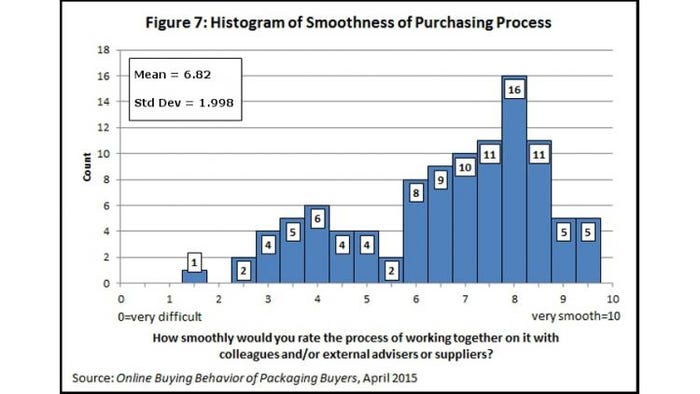
Digging further into this data, cluster analysis looked if there were any special patterns or correlations with the six buyer roles, use of social media, size of the budget and distance searched from work location.
Only distance was a factor. As the distance searched increased from local to global, the median rating went down from 8.35 to 6.15.
Looking at the dissatisfied buyers (ratings less than 6.0) showed they tended to be disproportionately Influencers who used the internet for defining needs and final vendor selection—and they tended to watch more videos.
Conclusions and next steps
Surely there is still room for improved convergence between the needs of packaging buyers as they search online for solutions versus the representations and content posted by suppliers.
Social media channels are currently providing limited value for buyers. But there is some significant difference in online behavior dependent upon the buyer’s role in the process and other purchase centric parameters such as distance searched and new purchases versus repeat purchases.
Smart suppliers will reassess their policies and tactics and search ability of their online content. When the content is found, buyers question much of its intent.
In the coming year, we intend to improve this research by expanding the number of responses. Further, a gap analysis will be carried out to investigate the gap between the reported perceptions of buyers herein and those of suppliers or supplier’s online content offerings. [12-2-15: Editor's note: Click here to read the gap analysis article.]

George Szanto is a tenured lecturer specialized in business-to-business (B2B) emarketing at Fontys University in the Netherlands. Prior to this, he held various international executive management positions in tech industries for more than 10 years.
Survey methodology
An online survey was used to collect input from the readers of this publication and other professional online groups (LinkedIn). Most of the participants had more than 10 years of experience in the industry. More than 40 people were owners of businesses or executive level managers. A majority of buyers were seeking packaging materials, but 55 also sought packaging machinery and 62 sought packaging related services. Most buying teams consisted of two to five people. Besides job function, we also characterized the buyers by one of seven roles they carried out during the purchase (such as Influencer, Decider, User and others).
About the Author(s)
You May Also Like




